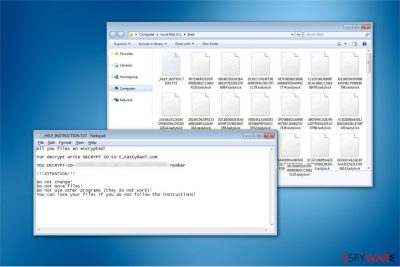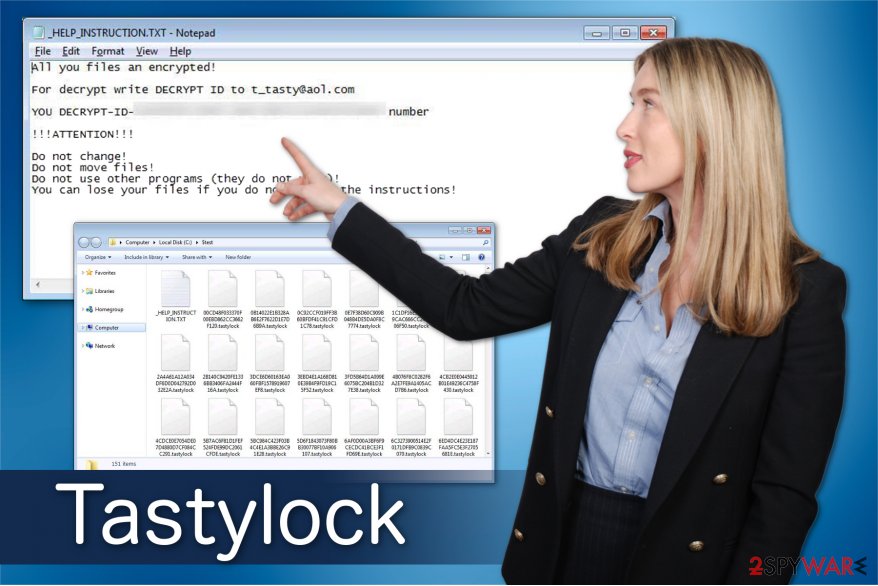Tastylock ransomware (Decryption Methods Included) - Removal Guide
Tastylock virus Removal Guide
What is Tastylock ransomware?
Tastylock ransomware is a slightly improved new variant of CryptoMix virus

Tastylock functions as a ransomware-type virus which encrypts the most widely used data and appends .tastylock extension at the end of the filenames. The victims receive a _HELP_INSTRUCTION.TXT file which serves as a ransom note and demands to make a payment in exchange for a decryption tool. Additionally, experts have found linkage to the infamous CryptoMix ransomware and consider this one to be an offspring.
The ransom note of Tastylock virus:
All you files an encrypted!
For decrypt write DECRYPT ID to t_tasty@aol.com
YOU DECRYPT-ID-[id] number!!!ATTENTION!!!
Do not change!
Do not move files!
Do not use other programs (they do not work)!
You can lose your files if you do not follow the instructions!
After encryption, Tastylock ransomware modifies the filenames to random characters and appends the suffix such as 0E7F38D60C909B048B4DE5DA0F8C7774.tastylock. The victims are encouraged to contact the criminals via t_tasty@aol.com email address. However, we do not recommend doing that.

Note that if you decide to pay the ransom, you have no guarantees that the crooks will provide you with a valid decryption key[1]. Additionally, the amount of the payment varies from 500-1500$ which would lead to substantial financial losses. We suggest you remove Tastylock as soon as possible and try to recover corrupted data from backups.
Do not panic if you do not keep copies of your files. You can still complete Tastylock removal and try alternative recovery methods which are presented at the end of this article. Since ransomware is one of the most dangerous type of the viruses, we recommend using FortectIntego.
Also, you should be aware that scammers try to benefit from desperate ransomware victims and offer expensive as well as useless decryption tools. Therefore, if you decide to use third-party tools, make sure that they are reliable and get Tastylock decryptor only from authorized experts.
Ransomware distribution methods
There are several most commonly used distribution techniques to spread the malicious programs worldwide. The most popular one is spam emails which deceive users by imitating legitimate companies or even governmental authorities[2]. Criminals send fake letters as invoices or shopping receipts to trick users into opening the infected attachment.
Once the obfuscate file is opened, the ransomware executable is dropped, and the computer is corrupted. Likewise, never open emails from people you do not know or companies you do not recognize having business with. Note that ransomware can even spread on social media platforms and you should be careful about not clicking on the infected link as well.
Additionally, we always recommend avoiding to download content illegally from peer-to-peer (P2P) networks. Usually, the crooks can design a genuine looking software update or the program itself to lure you into downloading the ransomware. Thus, make sure that you install/download applications only from verified developers or authorized distributors.
Also, experts from NoVirus.uk[3] say that the wisest decision would be to use a professional anti-malware software since it can protect you from manually infiltrating high-risk computer infections. You can use the ones our IT specialists recommend in the list below or pick your own.
Learn how to terminate Tastylock virus
An essential step in Tastylock removal is not to try to get rid of the ransomware executables or other components yourself. You can either fail to terminate it successfully or even damage your computer system permanently. Likewise, the only option to protect your PC is to use a powerful antivirus software.
To remove Tastylock you can use FortectIntego, SpyHunter 5Combo Cleaner, or Malwarebytes. They are reliable and expert-tested applications which are easy to use. You should start by rebooting your computer to Safe Mode. Later, download the security program and run a full system scan. If you are not aware how to complete the steps mentioned above, feel free to use the guide below.
Getting rid of Tastylock virus. Follow these steps
Manual removal using Safe Mode
Start Tastylock ransomware removal by rebooting your PC to Safe Mode with Networking.
Important! →
Manual removal guide might be too complicated for regular computer users. It requires advanced IT knowledge to be performed correctly (if vital system files are removed or damaged, it might result in full Windows compromise), and it also might take hours to complete. Therefore, we highly advise using the automatic method provided above instead.
Step 1. Access Safe Mode with Networking
Manual malware removal should be best performed in the Safe Mode environment.
Windows 7 / Vista / XP
- Click Start > Shutdown > Restart > OK.
- When your computer becomes active, start pressing F8 button (if that does not work, try F2, F12, Del, etc. – it all depends on your motherboard model) multiple times until you see the Advanced Boot Options window.
- Select Safe Mode with Networking from the list.

Windows 10 / Windows 8
- Right-click on Start button and select Settings.

- Scroll down to pick Update & Security.

- On the left side of the window, pick Recovery.
- Now scroll down to find Advanced Startup section.
- Click Restart now.

- Select Troubleshoot.

- Go to Advanced options.

- Select Startup Settings.

- Press Restart.
- Now press 5 or click 5) Enable Safe Mode with Networking.

Step 2. Shut down suspicious processes
Windows Task Manager is a useful tool that shows all the processes running in the background. If malware is running a process, you need to shut it down:
- Press Ctrl + Shift + Esc on your keyboard to open Windows Task Manager.
- Click on More details.

- Scroll down to Background processes section, and look for anything suspicious.
- Right-click and select Open file location.

- Go back to the process, right-click and pick End Task.

- Delete the contents of the malicious folder.
Step 3. Check program Startup
- Press Ctrl + Shift + Esc on your keyboard to open Windows Task Manager.
- Go to Startup tab.
- Right-click on the suspicious program and pick Disable.

Step 4. Delete virus files
Malware-related files can be found in various places within your computer. Here are instructions that could help you find them:
- Type in Disk Cleanup in Windows search and press Enter.

- Select the drive you want to clean (C: is your main drive by default and is likely to be the one that has malicious files in).
- Scroll through the Files to delete list and select the following:
Temporary Internet Files
Downloads
Recycle Bin
Temporary files - Pick Clean up system files.

- You can also look for other malicious files hidden in the following folders (type these entries in Windows Search and press Enter):
%AppData%
%LocalAppData%
%ProgramData%
%WinDir%
After you are finished, reboot the PC in normal mode.
Remove Tastylock using System Restore
If you couldn't boot your computer into Safe Mode, try this technique using Command Prompt.
-
Step 1: Reboot your computer to Safe Mode with Command Prompt
Windows 7 / Vista / XP- Click Start → Shutdown → Restart → OK.
- When your computer becomes active, start pressing F8 multiple times until you see the Advanced Boot Options window.
-
Select Command Prompt from the list

Windows 10 / Windows 8- Press the Power button at the Windows login screen. Now press and hold Shift, which is on your keyboard, and click Restart..
- Now select Troubleshoot → Advanced options → Startup Settings and finally press Restart.
-
Once your computer becomes active, select Enable Safe Mode with Command Prompt in Startup Settings window.

-
Step 2: Restore your system files and settings
-
Once the Command Prompt window shows up, enter cd restore and click Enter.

-
Now type rstrui.exe and press Enter again..

-
When a new window shows up, click Next and select your restore point that is prior the infiltration of Tastylock. After doing that, click Next.


-
Now click Yes to start system restore.

-
Once the Command Prompt window shows up, enter cd restore and click Enter.
Bonus: Recover your data
Guide which is presented above is supposed to help you remove Tastylock from your computer. To recover your encrypted files, we recommend using a detailed guide prepared by 2-spyware.com security experts.If your files are encrypted by Tastylock, you can use several methods to restore them:
Experts recommend using Data Recovery Pro tool
This is a professional file recovery tool designed to help ransomware victims retrieve most important files after the attack. Additionally, it can help you if you have accidentally deleted valuable documents yourself.
- Download Data Recovery Pro;
- Follow the steps of Data Recovery Setup and install the program on your computer;
- Launch it and scan your computer for files encrypted by Tastylock ransomware;
- Restore them.
Try CryptoMix decryptor
If your files were not encrypted using a unique key from a remote server, you should try CryptoMix decryptor.
Finally, you should always think about the protection of crypto-ransomwares. In order to protect your computer from Tastylock and other ransomwares, use a reputable anti-spyware, such as FortectIntego, SpyHunter 5Combo Cleaner or Malwarebytes
How to prevent from getting ransomware
Access your website securely from any location
When you work on the domain, site, blog, or different project that requires constant management, content creation, or coding, you may need to connect to the server and content management service more often. The best solution for creating a tighter network could be a dedicated/fixed IP address.
If you make your IP address static and set to your device, you can connect to the CMS from any location and do not create any additional issues for the server or network manager that needs to monitor connections and activities. VPN software providers like Private Internet Access can help you with such settings and offer the option to control the online reputation and manage projects easily from any part of the world.
Recover files after data-affecting malware attacks
While much of the data can be accidentally deleted due to various reasons, malware is one of the main culprits that can cause loss of pictures, documents, videos, and other important files. More serious malware infections lead to significant data loss when your documents, system files, and images get encrypted. In particular, ransomware is is a type of malware that focuses on such functions, so your files become useless without an ability to access them.
Even though there is little to no possibility to recover after file-locking threats, some applications have features for data recovery in the system. In some cases, Data Recovery Pro can also help to recover at least some portion of your data after data-locking virus infection or general cyber infection.
- ^ Paying for ransomware could cost you more than just the ransom. Trend Micro. Enterprise Cyber Security Solutions.
- ^ Anup Raman. How dangerous are Spam Mails. A Tech Journey. Computers, Hardware, Software, Gadgets, Tech Guides and Troubleshooting.
- ^ NoVirus. NoVirus. Security and Spyware News.





















